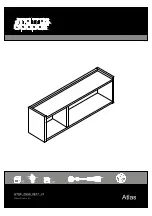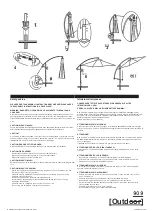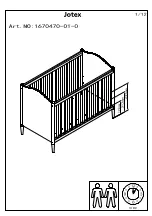
CSEES1KM 3 03/30/20
SETUP
Please refer to the exploded view drawing on page 5 in this manual in order to identify parts:
1. Insert the middle beam (#11) in the main post (#14) all the way until the ends of the square tubes are flush with each other and secure
them with a 3/4" long bolt (#10).
2. Secure the back leg (#3) to the angle iron portion of the main post (#14) and secure them together with the 2-3/4" long bolts (#9), flat
washers (#6), lock washers (#7) and nuts (#8).
3. Secure the front leg to the angle iron portion of the middle beam (#11) with the 2-3/4" long bolts (#9), flat washers (#6), lock washers
(#7) and nuts (#8).
4. Insert the two 3-1/2" diameter wheels (#1) into the bottom of the back leg (#3) and secure them to the leg with bolt (#2), washers (#5)
and nuts (#4).
5. Insert the two 3-1/2" caster assembly (#13) into the bottom of the front leg (#12) and secure them to the leg with bolt (#2), washers (#5)
and nuts (#4).
6. Install the tube section of the head mounting plate (#18) into the tube at the top of the main post (#14) and secure them together by
inserting the lock pin (#15) in the holes that line up between the two tubes.
7. Push one of the handle grips (#16) on the handle (#17) and insert the handle through the cross hole at the end of the head mounting
plate (#18). Now push on the remaining handle grip (#16) on the other end of the handle (#17).
8. Attach the four fingers (#22) to the head mounting plate (#18) with the 3" long bolts (#19), flat washers (#21), lock washers (#20) and
nuts (#23).
OPERATION
This is the safety alert symbol used for the
OPERATING INSTRUCTIONS
section of this manual to alert you to potential personal
injury hazards. Obey all instructions to avoid possible injury or death.
IMPORTANT:
Before attempting to raise any vehicle, check
vehicle service manual for recommended lifting surfaces.
1. Consult the vehicle or engine manufacturer for service manuals and/or technical bulletins that provide information on suggested engine
mounting tips, proper size and type mounting bolts and the engine's center of balance. The engine's center of balance will have to be
aligned with the rotational axis of the engine stand's mounting head.
2. Drain oil and coolant and remove clutch bell housing and flywheel from engine before mounting. Attach an engine lifting bar or sling to
the engine and secure the bar or sling to a shop crane or hoist. Slowly lift the engine from its compartment, making sure no other vehicle
components, wires or hoses obstruct the free movement of the engine. Raise the engine high enough so its center of balance is close to
the rotational axis of the stand's mounting head.
3. Make sure the four mounting head fingers are loosely connected to the mounting head plate. Secure the four mounting head fingers to
the bell housing end of the engine with the appropriate bolts and washers. Reposition the mounting head, fingers and engine so the
engine's center of balance is within one inch of the mounting head's rotational axis. Tighten all bolts to a sufficient torque requirement
that prevents any slippage.
4. Slowly lower the crane or hoist so the engine stand supports the full weight of the engine. To check engine balance and secure setup
of the engine to the stand, slowly rotate the engine by turning the handle. If balance or setup are not stable, rotate the engine to its
original position, raise the crane or hoist so the weight of the engine is removed from the stand, and make the correct adjustments. After
adjustments are made, tighten all bolts. This adjustment procedure may have to be duplicated several times until correct. After the setup
is balanced and secure, the lifting bar or sling can be removed from crane or hoist.
5. To remove the engine from the stand, connect the lifting bar or sling to the crane or hoist and raise the engine high enough to take
the weight off the stand. Carefully remove the bolts that connect the four mounting fingers to the engine. Be aware there will be a slight
movement of the stand as total engine weight is transferred to the crane or hoist.
PREVENTATIVE MAINTENANCE
This is the safety alert symbol used for the PREVENTATIVE MAINTENANCE section of this manual to alert you to potential
personal injury hazards. Obey all instructions to avoid possible injury or death.
1. Always store the engine stand in a well protected area where it will not be exposed to inclement weather, corrosive vapors, abrasive
dust, or any other harmful elements. The stand must be cleaned of water, snow, sand, grit, oil, grease or other foreign matter before
using.
2. Lubricate the wheels, casters, zerk fittings, gear and rotating shaft with a general purpose grease.
3. Every stand owner is responsible for keeping the device labels clean and readable. Use a mild soap solution to wash external surfaces
of the device. Contact Cornwell Tools for a replacement label if the device's label is not readable.
INSPECTION
Visual inspection should be made before each use of the engine stand, checking for damaged, loose or missing parts. Each engine stand
must be inspected by a manufacturer’s repair facility immediately, if subjected to an abnormal load or shock. Any stand which appears to
be damaged in any way, is found to be badly worn, or operates abnormally MUST BE REMOVED FROM SERVICE until necessary repairs are
made by a manufacturer’s authorized repair facility. It is recommended that an annual inspection of the stand be made by a manufacturer’s
authorized repair facility and that any defective parts, decals or warning labels be replaced with manufacturer’s specified parts. A list of
authorized repair facilities is available from the manufacturer.
CSEES1KM
750 LB.
ENGINE STAND























